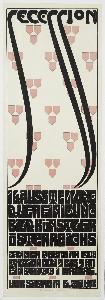Alfred Roller
Alfred Roller
Style: Art Nouveau;
Place: Brünn (Brno)
Born: 1864
Death: 1935
Biography:
Alfred Roller, an Austrian artist and designer, was born on October 2, 1864, in Brno. He is best known for his significant contributions to the Vienna Secession movement, which transformed Viennese art and design. As a professor of drawing at the University of Applied Arts Vienna, Roller played a crucial role in shaping the visual identity of the movement.
Early Life and Career
Roller's artistic style was influenced by his studies at the Academy of Fine Arts Vienna. He began his career as an artist, working on interior murals and ceilings in large public buildings. His work was characterized by a unique blend of Symbolism and Art Nouveau styles.
Vienna Secession
In 1897, Roller became one of the founders of the Vienna Secession, an avant-garde artists' association that promoted unconventional young artists. He was also a president of the Secession in 1902 and designed sets for several productions, including Wagner's Tristan und Isolde. His work with Gustav Klimt and others helped establish the Vienna Secession as a major force in the art world.
Notable Works
Some of Roller's notable works include Poster for the XVI Exhibition of the Vienna Secession, which showcased his unique style and technique. His work can be found in various museums, including the Österreichische Galerie Belvedere in Vienna.
- Art Nouveau: Roller's contributions to the Art Nouveau movement are still celebrated today.
- Vienna Secession: His work with the Vienna Secession helped establish the movement as a major force in the art world.
- Stage Design: Roller's designs for stage productions, including Wagner's Tristan und Isolde, showcased his unique style and technique.
Legacy
Roller's legacy can be seen in the many artists who followed in his footsteps. His contributions to the Vienna Secession and the Art Nouveau movement continue to inspire artists today. The Wikioo.org website features many of Roller's works, including Poster for the XVI Exhibition of the Vienna Secession, which can be found in their art database. To learn more about Alfred Roller and his contributions to the art world, visit the Wikioo.org website and explore their collection of Art Nouveau artists. https://Wikioo.org/@/Alfred-Roller https://en.wikipedia.org/wiki/Women_artists https://Wikioo.org/Art.nsf/O/A46MAT https://Wikioo.org/@@/A@D3C6E5



